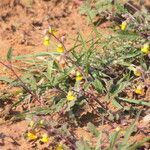Suffrutex, erect or suberect and widely branching at base; branches ascending, up to 60 cm tall; pubescence on branchlets, inflorescence and leaves varying from densely and smoothly to roughly and thinly tomentose, often with numerous minute gland-tipped hairs interspersed, or glabrescent with scattered rough stellate or tufted hairs. Stipules small (not leaf-like), subulate to deltoid-acuminate, 3-8 mm long, base 1-2.5 mm broad, rounded but not cordate, stellate-pubescent to stellate-tomentose. Leaves petiolate; blade variable in size and pubescence, ovate-oblong or broadly, rarely narrowly, oblong, occasionally suborbicular, 10-50 mm long, 6-30 mm broad, base broadly cuneate to rounded or somewhat cordate, apex rounded or rarely broadly acuminate and acute, margins faintly to distinctly crenate to base or almost so; pubescence varying from finely to softly stellate-tomentose on both surfaces to discolourous with upper surface roughly stellate-pubescent and lower surface softly whitish tomentose. Inflorescence of 1 or several, 1-to several-flowered cymes in axils of upper leaves and often forming terminal, leafless, paniculate cymes; branches of inflorescence from densely tomentose to glabrescent with scattered stellate or tufted hairs, but often (on inland specimens) with numerous, minute, gland-tipped hairs interspersed. Calyx campanulate, about 1-7 mm long, texture thin, from thinly to densely stellate-pubescent or tomentose outside, with a few hairs on inside near margin, lobed in upper third or almost to half way, lobes deltoid, sinuses wide. Petals yellow turning red at maturity, not long persistent, 7-11 mm long, upper third suborbicular, 5-6 mm diam., “waist” 1.5-2 mm broad, lower portion with infolded margins, glabrous or obscurely ciliate and pubescent within, not tomentose along edges of claw. Stamens about 5 mm long, with broad, hyaline, obovate filaments ciliate on shoulder; anthers overlapping the filaments at base, ciliate. Ovary 4 mm long, 5-angled, stellate-pubescent, 5-umbonate at apex, shortly stipitate at base, styles adhering. Capsule usually exposed, up to 8 mm long, about as long as petals.
More
Suffrutex, 0.3-0.6 m high, bark dark brown; plant with sessile, short-rayed and tubercle-based, long-rayed, stellate hairs, intermixed with stipitate glands. Leaves petiolate, ovate-oblong; upper surface, venation sunken, stellate-pubescent between veins; lower surface, venation prominent, softly whitish tomentose. Stipules ± subulate. Inflorescences of one or few, 1-several-flowered cymes in axils of upper leaves; peduncles up to 10 mm long; pedicels densely pubescent. Flowers up to 11 mm long, yellow, red. Calyx campanulate, thin-textured, 5-lobed in upper 1/3, sinuses wide; ± densely stellate-pubescent. Petals upper 1/3 suborbicular, narrowing into a claw. Flowering time Aug.-May. Fruit a capsule, as long as petals.
Dwarf shrub, up to 0.6 m high. Stems erect or suberect; densely tomentose to glabrescent. Leaves petiolate; blade variable, ovate-oblong to narrowly oblong, margins crenate, upper and lower surfaces with glabrescent hairs. Flowers: in 2-flowered cymes in axils of upper leaves, forming terminal, leafless, paniculate cymes; calyx campanulate; petals yellow turning red at maturity; Sep.-Mar.
Like H. rugosa but leaves not crisped.

